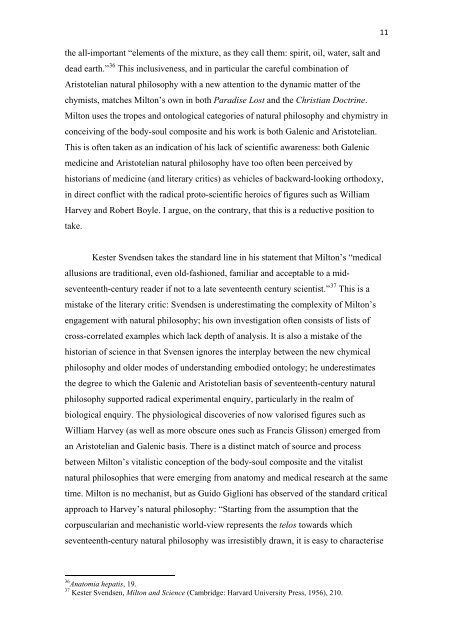Medical Science and the Anatomia Animata in Milton's Paradise Lost
Medical Science and the Anatomia Animata in Milton's Paradise Lost
Medical Science and the Anatomia Animata in Milton's Paradise Lost
Create successful ePaper yourself
Turn your PDF publications into a flip-book with our unique Google optimized e-Paper software.
<strong>the</strong> all-important “elements of <strong>the</strong> mixture, as <strong>the</strong>y call <strong>the</strong>m: spirit, oil, water, salt <strong>and</strong><br />
dead earth.” 36<br />
This <strong>in</strong>clusiveness, <strong>and</strong> <strong>in</strong> particular <strong>the</strong> careful comb<strong>in</strong>ation of<br />
Aristotelian natural philosophy with a new attention to <strong>the</strong> dynamic matter of <strong>the</strong><br />
chymists, matches Milton’s own <strong>in</strong> both <strong>Paradise</strong> <strong>Lost</strong> <strong>and</strong> <strong>the</strong> Christian Doctr<strong>in</strong>e.<br />
Milton uses <strong>the</strong> tropes <strong>and</strong> ontological categories of natural philosophy <strong>and</strong> chymistry <strong>in</strong><br />
conceiv<strong>in</strong>g of <strong>the</strong> body-soul composite <strong>and</strong> his work is both Galenic <strong>and</strong> Aristotelian.<br />
This is often taken as an <strong>in</strong>dication of his lack of scientific awareness: both Galenic<br />
medic<strong>in</strong>e <strong>and</strong> Aristotelian natural philosophy have too often been perceived by<br />
historians of medic<strong>in</strong>e (<strong>and</strong> literary critics) as vehicles of backward-look<strong>in</strong>g orthodoxy,<br />
<strong>in</strong> direct conflict with <strong>the</strong> radical proto-scientific heroics of figures such as William<br />
Harvey <strong>and</strong> Robert Boyle. I argue, on <strong>the</strong> contrary, that this is a reductive position to<br />
take.<br />
Kester Svendsen takes <strong>the</strong> st<strong>and</strong>ard l<strong>in</strong>e <strong>in</strong> his statement that Milton’s “medical<br />
allusions are traditional, even old-fashioned, familiar <strong>and</strong> acceptable to a midseventeenth-century<br />
reader if not to a late seventeenth century scientist.” 37<br />
This is a<br />
mistake of <strong>the</strong> literary critic: Svendsen is underestimat<strong>in</strong>g <strong>the</strong> complexity of Milton’s<br />
engagement with natural philosophy; his own <strong>in</strong>vestigation often consists of lists of<br />
cross-correlated examples which lack depth of analysis. It is also a mistake of <strong>the</strong><br />
historian of science <strong>in</strong> that Svensen ignores <strong>the</strong> <strong>in</strong>terplay between <strong>the</strong> new chymical<br />
philosophy <strong>and</strong> older modes of underst<strong>and</strong><strong>in</strong>g embodied ontology; he underestimates<br />
<strong>the</strong> degree to which <strong>the</strong> Galenic <strong>and</strong> Aristotelian basis of seventeenth-century natural<br />
philosophy supported radical experimental enquiry, particularly <strong>in</strong> <strong>the</strong> realm of<br />
biological enquiry. The physiological discoveries of now valorised figures such as<br />
William Harvey (as well as more obscure ones such as Francis Glisson) emerged from<br />
an Aristotelian <strong>and</strong> Galenic basis. There is a dist<strong>in</strong>ct match of source <strong>and</strong> process<br />
between Milton’s vitalistic conception of <strong>the</strong> body-soul composite <strong>and</strong> <strong>the</strong> vitalist<br />
natural philosophies that were emerg<strong>in</strong>g from anatomy <strong>and</strong> medical research at <strong>the</strong> same<br />
time. Milton is no mechanist, but as Guido Giglioni has observed of <strong>the</strong> st<strong>and</strong>ard critical<br />
approach to Harvey’s natural philosophy: “Start<strong>in</strong>g from <strong>the</strong> assumption that <strong>the</strong><br />
corpuscularian <strong>and</strong> mechanistic world-view represents <strong>the</strong> telos towards which<br />
seventeenth-century natural philosophy was irresistibly drawn, it is easy to characterise<br />
36<br />
<strong>Anatomia</strong> hepatis, 19.<br />
37<br />
Kester Svendsen, Milton <strong>and</strong> <strong>Science</strong> (Cambridge: Harvard University Press, 1956), 210.<br />
11
















